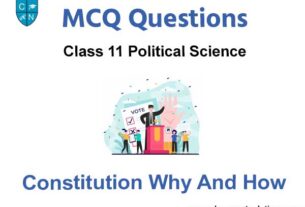Check the below NCERT MCQ Class 11 Economics Chapter 3 Liberalisation, Privatisation and Globalisation with Answers available with PDF free download. MCQ Questions for Class 11 Economics with Answers were prepared based on the latest syllabus and examination pattern issued by CBSE, NCERT and KVS. Our teachers have provided below Liberalisation, Privatisation and Globalisation Class 11 Economics MCQs Questions with answers which will help students to revise and get more marks in exams
Liberalisation, Privatisation and Globalisation Class 11 Economics MCQ Questions with Answers
Refer below for MCQ Questions Class 11 Economics Chapter 3 Liberalisation, Privatisation and Globalisation with solutions. Solve questions and compare with the answers provided below
Question. International Bank for Reconstruction and Development(IBRD) is popularly known as :
(a) World Bank
(b) Bank of Tokyo
(c) American Express
(d) HSBC Bank
Answer
A
Question. IMF stands for :
(a) International Monetary Foundation
(b) Internal Monetary Fund
(c ) International Monetary Fund
(d) International money foundation
Answer
C
Question. Rate of which tax was reduced as per the tax reforms:
(a) Income tax
(b) corporation tax
(c) value –added tax
(d) property tax
Answer
B
Question. The Foreign Trade Policy has ______
(a) identified certain thrust areas for growth
(b) started “served from India brand”
(c) started duty-free export credit
(d) all of above
Answer
D
Question. CIF stands for :
(a) Cost, insurance, freight
(b) Cost inclusive of freight
(c) Cost in freight
(d) Cost, interest, freight
Answer
A
Question. ______ refers to the relaxation of produce government restriction usually in areas of social and economic policies:
(a) Privatisation
(b) Globalisation
(c) Disinvestment
(d) Liberalisation
Answer
D
Question. Industrialisation in India has recorded a slowdown in the period of economic reforms. What is/are the reason(s) for this?
(a) The demand for domestic industrial products is decreasing.
(b) Globalisation
(c) India does not have access to different markets because of high non-tariff barriers.
(d) All of the above
Answer
D
Question. India started economic reforms in:
(a) 1990
(b) 1991
(c) 1992
(d) 1995
Answer
B
Question. Industrial growth in India has recorded a slowdown in the period of economic reforms. What are the reasons for this?
(a) Decreasing demand of domestic industrial products
(b) Globalisation
(c) India does not have access to different markets because of high non-tariff barriers.
(d) All the above
Answer
D
Question. Why in India, Industrial sector growth has lowered down?
(a) Due to availability of cheaper imports and lower investment
(b) Income of public has increased
(c) Exports are giving good response
(d) Manpower has decreased in industries
Answer
A
Question. Industrialisation in India has recorded a slowdown in the period of economic reforms. What are the reasons for this?
(a) Decreasing demand for domestic industrial products
(b) Globalisation
(c) India doesn’t have access to different markets because of high non-tariff barriers
(d) All of the above
Answer
D
Question. Which among the following is NOT a pillar of economic reforms
(a) Liberalisation
(b) Privatisation
(c) Nationalisation
(d) Globalisation
Answer
C
Question. Which is the latest tax introduced by the government of India?
(a) Goods and services tax
(b) Value –added tax
(c) service tax
(d) corporation tax
Answer
A
Question. What was the one major proposal of new industrial policy(1991)?
(a) NRI’s will not be allowed for capital investment in India.
(b) Facility of FDI upto 51 percent in high priority industries
(c) Import restrictions on technical know how for one year
(d) Abolition of industrial licencing except for six industries.
Answer
C
Question. Objectives of privatization policy are :
(a)To improve the government’s financial position
(b) To improve the performance of an enterprise
(c) To reduce the burden on public administration.
(d) All the above.
Answer
A

